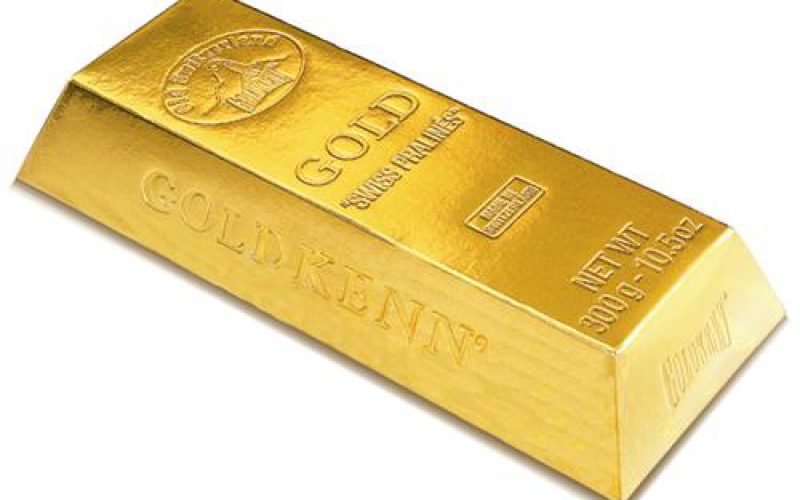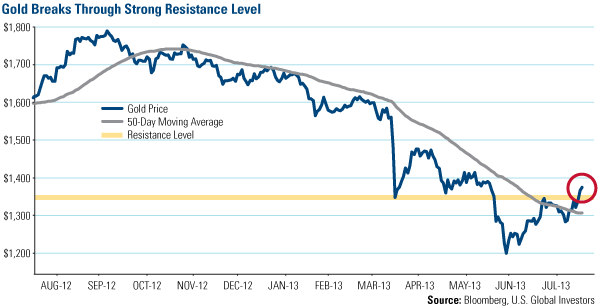Gold Market Radar (August 19, 2013)
For the week, spot gold closed at $1,376.87, up $62.47 per ounce, or 4.75 percent. Gold stocks, as measured by the NYSE Arca Gold Miners Index, rose 12.51 percent. The U.S. Trade-Weighted Dollar Index rose 0.21 percent for the week.
Strengths
- The recent price action of gold seen in the chart below was is undoubtedly the most important news in the gold sector this week. Gold broke away from its 50 day moving average in convincing fashion, while also breaking above the approximately $1,340 per ounce horizontal resistance level. The rise is even more convincing when seen in the context of 10 year Treasury rates reaching 2.84 percent, the level seen just before the U.S. debt downgrade in August 2011. Our outlook for gold is positive having seen the action and volume this week, and entering the historically best seasonality for gold.
- The strong July import data for the Chinese economy announced on August 8 (up 10.4 percent) indicates a stronger-than-expected domestic demand recovery, which hopefully bodes well for gold demand. In fact, China July gold sales were up 41 percent. Silver is not lagging behind; if anything it is moving ahead of gold. Sales of American Eagle Silver coins by the U.S. Mint rose to 31 million ounces year to date, closing in on the 33.7 million ounces sold in 2012.
- Kip Keen of Mineweb reports on Calibre Mining Corp. recent performance: Back in March Calibre Mining released sampling results, primarily for gold, from its Montes de Oro project in Nicaragua reporting 9 meters intercept at 10.76 grams per ton gold. By early June the trench grew longer with Calibre reporting 17 meters at 17.95 grams per ton. Calibre's latest sampling results out this Thursday, trench 009 stretches to 52 meters at 7.1 grams per ton. Calibre shares flew, tripling at one point Thursday on a wave of heavy volume surpassing 5 million. The price action highlights one of Paradigm Capital’s 10 reasons to buy gold research report. Development [and exploration] stage companies are trading well below discovery cost. These companies are currently trading at $40 per ounce of estimated mineable resource; about half of what Paradigm believes the global finding cost is for economically viable projects in acceptable jurisdictions.
Weaknesses
- Gold in the second quarter of 2013 was extremely popular with retail consumers and investors, especially in Asia, but not institutional investors and central banks, the latest World Gold Council data suggests. What we learned over the quarter is that the price outlook is still very much dependent on ETF flows. The GLD ETF was responsible for 63 percent of the 671 tonnes of outflows seen in the first seven months of 2013. Macquarie reports that despite GLD seeing inflows in the last week from August 9 to August 14, the ETF flows represent a new reality that gold investors have to live with.
- The World Gold Council also reported central banks are expected to buy fewer gold bars than previously expected in 2013. Central banks are now expected to be net buyers of 300 to 350 tonnes of gold in 2013, down from an earlier forecast of 400 to 450 tonnes. In a counterintuitive rationale, central banks appear to be avoiding new purchases as policy makers fear further price declines. Regardless, central bank buying has been strong over the last ten quarters and will remain a source of demand for the foreseeable future.
- The dollar registered its biggest weekly advance in more than a month against the yen as gains in new home construction and worker productivity added to signs the world’s biggest economy is improving. The release of indicators beating expectations increases the likelihood of the Fed tapering this September. In the past, the stronger dollar has proven to be the main factor in driving commodity prices lower, while also adding downward pressure to gold.
Opportunities
- Once again gold forward offered rates (GOFO) have turned negative, which according to Euro Pacific Capital research, means banks which had lent their customers gold to obtain a positive return, and therefore increase the "paper" gold supply, are looking forward to take the gold back in exchange for the paper. This is cited as one of the main reasons for the strong performance of the yellow metal this week, as bank demand for physical gold limits the amount of gold available on the market. In addition, gold bullion ETF liquidations stopped this week, the first time since December, coinciding with the renewed strength in bullion.
- Significant operating cost savings will begin to appear in the fourth quarter for gold stocks, helping turn around the earnings per share and cash flow per share downtrend, according to Paradigm Capital. In the past, global total cash costs dropped 27 percent from 1996 to 1999 in response to a 28 percent decrease in the average gold price in those years. Paradigm estimates a $150–$200 per ounce reduction in all-in costs should be possible by the end of 2014, giving the magnitude of the price decline this year, with the first meaningful results showing in fourth quarter 2014 to first quarter 2014.
- In the same research note, Paradigm Capital explains gold exploration is imploding, which reduces the production growth outlook and decreases the certainty of the long-term future supply. Exploration budgets have been slashed by the majors by a one-third to one-half and deeper cuts cannot be ruled out. According to Paradigm, the roughly 80 gold exploration companies are trading at a median of only 11 percent of their four year highs, making it a challenge to raise debt or equity. As a result, a large portion of the explorers will go dormant. These developments will eventually transmit into scarcity of the metal which should lift prices.
Threats
- The Indian government continues to ignore the fact that its war against gold imports continues to be unsuccessful. This week, the government announced that it is to raise the import duty on gold yet again, this time from 8 percent to 10 percent. The news follow the release of gold import data showing import figures of 383 tonnes from April to July; a sharp increase on the 205 tonnes it imported in the same period in 2012. Duties on silver imports were also increased from 6 percent to 10 percent to try and control the growing imports of physical silver. But not content with these, the government also raised duties on platinum imports from 8 percent to 10 percent. To top the week, the Reserve Bank of India followed, almost immediately, with one more ridiculous flip flop by outright banning the import of gold coins. The only question in bullion traders’ minds is how long the government will last before it eventually gives up.
- The recent U.S. jobs numbers paint too bright a picture. Looking at independent surveys, it could be said the markets are too focused on jobs headline numbers only. This Friday’s Gallup poll for U.S. underemployed workforce shows the number of respondents employed part time, but looking for a full time job increased to 17.6 percent, while the percentage of unemployed respondents increased to 8.4 percent, a full 1 percent above the official number of 7.4 percent. It is evident to us that independent surveys tell a different story in which the macroeconomic indicators are either worsening or improving only sluggishly.
- Some of the world's top money managers revealed their holdings in quarterly filings with the Securities and Exchange Commission on Wednesday, giving investors a glimpse at the moves they made during the second quarter. Hedge fund manager John Paulson, famous for making a fortune betting against subprime mortgages, reduced his holdings in a gold bullion ETF from $3.4 billion at the end of the first quarter to $1.2 billion. In addition, George Soros also disposed of his gold ETF holdings, which were worth nearly $82 million as of the end of the first quarter. It is impossible to know if these moguls reinvested their capital in another form of a gold investment vehicle, which would not be unlikely of Paulson, however the size of ETF liquidations resulting from their rebalancing is unlikely to repeat and should take downward pressure off of bullion.
















